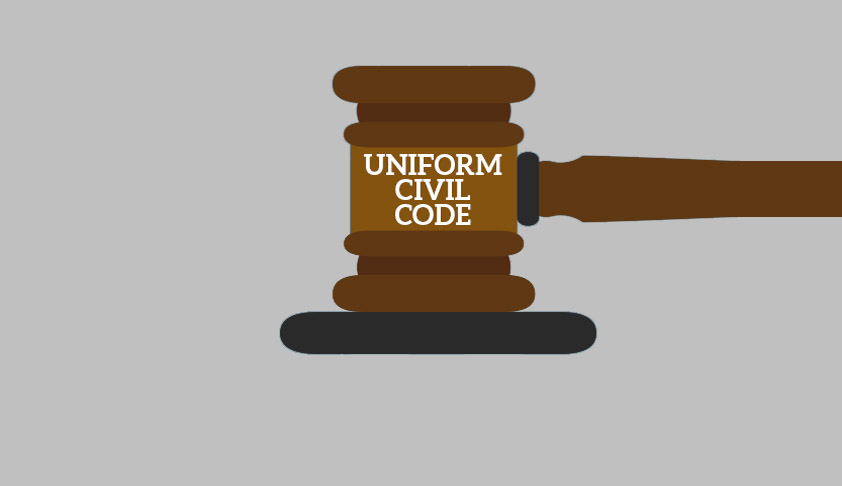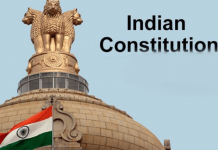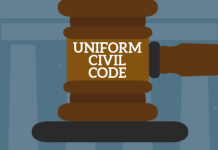This article is written by Saurav Narayan practising advocate at Delhi High Court. This article has been edited by Yashprada (Associate, Lawsikho).
This article has been published by Sneha Mahawar.
Table of Contents
Introduction
In one sense, the notion of a Uniform Civil Code is derived from the concept of secularism, and it also supports secularism in establishing deep and broad roots. Secularism, it is said, refers to a broad and fundamental, primordial, and substantial trend in the formation of human thinking and experience. The removal and isolation of religion from other areas of life and thinking constitutes the secularization of life and philosophy. Secularism, as a concept of non-discrimination based on religion, is a result of the rule of law and is necessary for the rule of law to thrive. This notion is infused in the whole constitutional fabric and is meant to be a way of life and a point of view. Secularism entails equal regard for all religions—positively, tolerance and acceptance, and negatively, the exclusion of religion from other areas of life in the negative meaning. Secularism also implies that common citizenship presupposes common family law in all civil concerns, including family.
Religions have had a massive impact on Indian politics and society and have acted as the cornerstone of Indian culture. Religion can be said to be a way of life in India. It is an essential aspect of Indian culture. In subjects such as marriage, divorce, inheritance, and adoption, the Uniform Civil Code asks for the creation of a single law for India that would apply to all religious sects be it Hindu, Muslim, Christian, Sikhs and others. The code is based on Article 44 of the Constitution, which states that the state must work to ensure that citizens throughout India have access to a uniform civil code. However, according to Article 37 of the Constitution Article 44 is not a mandate. The Government of India has not committed its attention to fulfilling this positive responsibility imposed by the Indian Constitution. This fact is in and of itself a roadblock to its implementation. Another stumbling block is the vast ability of the Indian Parliament and State legislatures to act on most of the issues that may be included in the standard civil code. And the primary impediment is that various religious groups have separate personal rules that they hold dear and do not want any outside body interfering with. Nonetheless, the State must pay close attention to the objectives outlined in Article 44 of the Indian Constitution and make every effort to put them into action as quickly as possible. However, making a single large code that covers all aspects of marriage, divorce, succession, adoption, and so on may make altering the people’s age-old traditions and customs extremely difficult.
Historical background
Mughals ruled India before the arrival of the British, that is, before 1612. During the Mughal period, justice was administered by Qazis who applied Muslim law to Muslims, but there was no such guarantee when it came to disputes involving Hindus. On the criminal side, under the Mughal Nawab, the country’s law was Muslim criminal law, which was applied uniformly to everyone and governed by Qazis and Muftis.
During the British period, the Mughal system of judicial administration was mostly maintained until 1772. Warren Hastings’ Judicial (Administrative) Plan of 1772 established uniform civil courts throughout the mofussil areas of Bengal, Bihar, and Orissa, which bordered the Calcutta presidency, for the native people, without distinction between Hindus and Mohammedans. On the civil side, the courts were to apply the personal laws of the various religious communities, such as Hindu law for Hindus, Muslim law for Muslims, Christian law for Christians, Parsee law for Parsees, and Jewish law for Jews. On the criminal side, the Muslim criminal law was applied universally to all religious sects in India and was updated by regulations from time to time. Company courts operated in the Mofussil area, and legal expertise was not required for selection as a judge in the court. After 1781, the Supreme Court, founded in 1774 in the Calcutta Presidency under the Regulating Act of 1773, started to apply just three systems of law: Hindu law, Muslim law, and English law. On the civil side, the Supreme Court applied Hindu law to Hindus and Muslim law to Muslims and English law to the rest of the religious communities, as applied under the theory of justice, equity, and good conscience.
The Supreme Court was to have authority within the presidency towns and over British citizens living in the mofussil territory beyond the presidency towns, namely Bengal, Bihar, and Orissa. On the criminal side, it adapted a great deal to the local situations in India.
The Warren Hastings Regulations of 1772 were followed by the regulations of 1781, which stated that in terms of inheritance, marriage, religious practice, and institutions, either community was to be administered by its law. In terms of criminal justice, the British eventually supplanted Muslim criminal law with English law. In 1790, Lord Cornwallis, the Governor-General of Calcutta, introduced changes to improve criminal justice administration and implemented ameliorative measures in criminal law and procedure. The English common law regulated criminal justice by 1832. In 1860, the Indian Penal Code was finally enacted. This broad approach persisted throughout the British reign until India’s independence when the British authorities divided the country into two states based on religion. Those who wished to remain in India after the partition understood Indian authorities did not subscribe to the two-nation or three-nation theories. And that there would be just one country in the Indian republic – India – and no group could claim to be a distinct entity based on religion. It is important to emphasize that the British only allowed the various personal laws to govern topics like inheritance, marriage, and so on under Warren Hastings’ rules of 1781.
Personal law, rather than religion, was permitted to exist and operate under government authority, and this can be superseded/supplemented by passing a Uniform Civil Code. No community, in this opinion, can argue against the implementation of a Uniform Civil Code for all people of India’s territory. In 1835, Lord McCauley was selected to lead the First Law Commission. According to the Commission, non-Hindus and non-Muslims have no lex loci or local law. Hindus and Muslims, the two biggest faiths, have rules that are interwoven with their religion. The Commission mentioned consistency of law and stated that India does not have any lex loci? India still lacks a lex loci in personal law. Let us now look at the personal law that applies to diverse groups in India.
Mitakshara and Dayabhaga law controlled Hindus before independence. Even Mitakshara regulations were not enforced consistently, resulting in the formation of four distinct sub-schools. As a result, Hindus have their own set of personal laws that apply to them. Most Indian provinces and states have begun to create their Hindu laws. Likewise, Muslim Sunni and Shia were separated into two primary groups.
Although Muslim personal law is drawn from the same source, the Holy Quran, these two groups differ in how personal law is applied to them. Sunnis are further separated into four sub-schools, whilst Shias are grouped into three sub-schools. The Dissolution of Muslim Marriages Act was passed in 1939, allowing Muslim wives to divorce their husbands through the courts. Christians, who are separated into two major factions, Catholics, and Protestants, are in the same boat. The Christian Marriage Act of 1827 and the Indian Divorce Act of 1869 codify their law. Parsees have their own set of personal laws that apply to them. As a result, India’s laws lack a consistent civil code for Indians.
India has five major religious communities: Hindus, Buddhists, Jains, Muslims and Sikhs and all are represented by their laws. Each religious community has its own set of rules. Not only that, but there are also differences in rules based on sex, sect, residence, and the type of marriage performed within each of these groups. Apart from this, there are still many customary laws that apply to various groups.
With the amalgamation of the union territories of Goa, Daman, and Diu in 1961 and the union territory of Pondicherry in 1962, two foreign legal systems were introduced into the previously existing composite system of personal laws. The Portuguese Civil Code, 1867, which is based on Code Napoleon, is the general legislation that applies to all residents of Goa, Daman, and Dieu. However, by 1880, the Portuguese had maintained several Hindu practices and rituals among Goa’s Gentile Hindus. Hindus in Daman and Dieu were also subjected to laws. The legal situation in this regard has remained unaltered to this day. The French Civil Code, 1802 is in effect in Pondicherry and applies to all residents. In the years following independence, the Indian Parliament codified and altered the Hindu personal law. Other religious organizations’ laws remained unaffected, except the Special Marriage Act of 1954, which applied equally to all religious communities.
Uniform Civil Code at the Constituent Assembly
The debates in the Constituent Assembly on draft Article 35, which is now Article 44, enjoining the development of a Uniform Civil Code, are highly instructive and place the matter in its correct context. The anxieties and misgivings of some of the members of the Muslim minority community were allayed, and the legal stance on a Uniform Civil Code was placed into perspective. It was pointed out that after the Constituent Assembly unanimously adopted draft Article 19, which is now Article 25, which in clause (2)(a) provides for the regulation or restriction by the law of any secular activity not associated with religious practice, and that marriage and succession are secular aspects that cannot be considered essential parts of religion, Article 44 (draft Article 35) is a natural follow-up.
It’s important to remember what some of the Constituent Assembly’s leaders and Constitution-makers said.
Mahboob Ali Beg underlined that the civil code mentioned in Article 35 did not encompass family law or inheritance. Still, since some people are unsure, a provision should be added to ensure that the civil code covers property transfers, contracts, and other items governed by personal laws.
M.A. Ayyangar, a member of the Constituent Assembly, spoke out and said it was a contract issue. Ayyangar endeavored to make a strong case, claiming that the Holy Quran and the Prophet’s Traditions prohibited the marriage contract. He said that the Indian notion of secularism accepted all religions with equal respect and dignity. He emphasized that diverse communities must be permitted to exercise their religion and culture in a secular state like India and follow their own laws.
Furthermore, Hindu and Muslim organizations questioned the Constituent Assembly’s authority to intervene with religious legislation. As a result, Article 35 was anti-religious liberty.
K.M. Munshi presented his views, claiming that it would be legal for Parliament to enact a uniform civil code even if Article 35 did not exist because the article ensuring religious freedom provided the State with the ability to control secular activities related to religion.
Dr B.R. Ambedkar rejected the revisions and supported the State’s ability to intervene in the personal laws of distinct communities. He stood up for the laws of several communities. He backed the Hindu members of the Constituent Assembly’s arguments. But, at the same time, he provided Muslim members with some guarantees, explaining that the plan only created a ‘power,’ not a ‘duty. ‘Furthermore, Dr Ambedkar advised Muslim members not to “read too much into Article 44.” Even if the Uniform Civil Code is enacted, he claims that it will only apply to those who choose to be controlled by it.
After the debates, the members overwhelmingly voted to include a Uniform Civil Code in the Constitution.
Conflicts of personal laws
India is a diverse country with many different cultures and communities. India is home to several world-famous faiths and cultures. Throughout India’s history, religion has played a significant role in the country’s culture. Law and tradition both foster religious variety and tolerance in the country. Even in a country with secularism written into its Constitution, there is a conflict in the notion of secularism, especially when seen considering its citizens’ laws. It has become a perplexing melting pot of Hindus, Muslims, Christians, and Parsees, each with its own set of personal rules governing marriage, adoption, guardianship, divorce, and succession, among other things. In India, almost every community has its own set of personal rules about marriage and divorce. Although several different sects live as citizens of the same nation, India’s family laws range from one faith to the next. This is because the customs, social usage, and religious interpretation of these societies as they live their lives are heavily influenced by the religion they were born into and the laws that govern society. Marriage, divorce, property, and inheritance are among the codified personal laws:
- The 1872 Indian Christian Marriage Act (applicable to the whole of India except areas of erstwhile Travancore-cochin Manipur and Jammu & Kashmir);
- The Cochin Christian Civil Marriage Act of 1920 (which applies to Travancore-Cochin areas);
- The Anand Marriage Act of 1909 governs Sikh weddings;
- The Muslim Personal Law (Shariat) Application Act of 1937 (which establishes Shariat legislation applicable to Muslims in India);
- The Parsi Marriage and Divorce Act (Parsi Marriage and Divorce Act) (Parsi Marriage and Divorce Act) ;
- Hindu Marriage Act of 1955 (applicable not just to Hindus, Buddhists, and Jains, but also to non-Hindus, Buddhists, and Jains also to anybody who is not a Muslim, Christian, Parsi, or Jew-controlled by a different set of rules).
Part III of the Indian Constitution clashes with personal laws
Two situations must be explored to determine the conflicts:
- Personal laws codified and customary in practice contradicts Part III of the Indian Constitution.
- Personal law conflict tries to change current laws that have been judged to be arbitrary and unlawful under Article 25 of the Indian Constitution.
Since the commencement of the Indian Constitution, the Indian court has struggled to determine the relationship between personal laws and Part III of the Indian Constitution. The Narasu Appa Mali Case is a historic and important ruling that sheds some light on this conundrum.
Bombay State v. Narasu Appa Mali
The legitimacy of the “Bombay Prohibition of Bigamous Marriage Act 1946,” whose validity was challenged under Articles 14, 15, and 25 of the Indian Constitution, was a question in the case. The questions before the court were:
- Whether Hindu personal rules are “law” as defined by Article 13(3)(b) and Article 372(3), Explanation 1?
- Whether a change in one religious community’s law without an equivalent change in another breaches the principle of legal equality?
The court ruled as follows:
- Personal laws do not fall within the definition of “law” as defined in Article 13(3), nor do they fall under the definition of “law in effect” as defined in Article 372. (3). Article 14 was held to be unaffected by the Bombay Prevention of Hindu Bigamous Marriage Act, 1946, since the State was permitted to implement social reforms in stages.
- If religious practices are incompatible with public order, morality, or a social welfare policy entrusted to the State, the general welfare of the people of the State will be prioritized over religious activities.
Let us look at the issue in Sarla Mudgal v Union of India where the question in point was whether a Hindu man who was married under Hindu law can solemnize a second marriage by converting to Islam. Supreme Court observed that adopting Islam for a second marriage is a violation of personal laws. Further, Hindu marriages can be dissolved under the Hindu Marriage Act, 1955, i.e. just converting to Islam and marrying again would not terminate the marriage under Hindu Marriage Law, and hence will be a violation of Section 494 of the Indian Penal Code.
Distinction in various personal laws
India is a country full of a diverse population and their various laws which all have their own distinctions, some of which are as follows:
- Polygamy is permitted under Muslim law, but not under Hindu, Parsee and Christian law.
- Marriage definition—Muslim law specifies that a female witness is not the same as a male witness.
- Marriage is a civil contract in Muslim law, but it is still viewed as a sacramental union under Hindu law, but only in part.
- Muslim males are permitted to divorce without going through the courts, but Hindu, Christian, and Parsee males and females can only divorce through the courts.
- Muslim women can only be divorced in a court of law for specific reasons. Female Hindus, Christians, and Parsees are all in the same boat.
- A Muslim marriage is automatically dissolved if the husband abandons Islam, but not if the wife abandons Islam. According to Hindu law, a spouse who converts to another faith gives the other spouse the right to divorce. Under Parsee law, the situation is the same. Apostasy does not impair a marriage in Christian law, but if the apostate husband marries again, the woman has the right to divorce.
- According to Muslim law, a divorced wife cannot marry her prior husband unless she first remarries to another man who has granted her a divorce or has died after the marriage has been consummated. There is no such criterion in Hindu, Christian, and Parsee law.
- Except for the iddat period, a divorced woman is not entitled to any maintenance under Muslim law. Maintenance for a divorced wife is permitted under Hindu, Christian, and Parsee law until her death or remarriage.
- A daughter inherits half of a son’s portion under Muslim law.
- A person cannot dispose of more than 1/3 of his property by will under Muslim law, while no such restriction exists under other personal laws. In the case of Hindu joint family property, one can only dispose of his portion, not the entire joint family property, by will.
- A female is not a coparcener under Mitakshara law. Coparcenary is a male-only organization. Other personal laws do not have a structure like this. The notion of coparcenary is still in use today, even after the enactment of the Hindu Succession Act of 1956.
- Muslim law acknowledges paternity and consequently the validity of the child, although other laws do not.
- Adoption is not recognized by Muslim, Christian, or Parsee law, but it is recognized by Hindu law.
- A child is considered legitimate under Muslim law if it is born between a certain length of separation between spouses (after divorce or otherwise), which varies from 10 months to 4 years. The courts in India have refused to recognize the Hanafi law, which allows for a two-year separation, and the Shafi law, which allows for a four-year separation since they cannot occur naturally. If the separation time is more than 270-280 days, Hindu, Christian, and Parsee laws do not confer legitimacy.
Suggestions
The present patterns show how little progress has been made in obtaining a UCC and how difficult the work remains. In this regard, the following suggestions are made:
- While uniform legislation is important, enacting it all at once may harm the nation’s unity and integrity. Gradual progressive legislation should be implemented in a democracy ruled by the rule of law. At different levels, the legal system can correct the most serious problem.
- The greatest method to change people’s habits and customs is to do so gradually. Instead of creating a single civil code that covers all aspects of family law, it would be preferable to create piecemeal standard laws in specific areas such as adoption, maintenance, divorce, marriage, inheritance, etc.
- A comparison of the numerous personal laws should be conducted to determine the similarities and differences between their provisions. Based on those principles, which are almost similar under all personal laws, personal status legislation can be instantly adopted and implemented.
- A family law board, similar to the business law board under the Ministry of Industrial Affairs, should be established under the Union Law Ministry.
- The causes for the ineffectiveness of current family legislation, such as the Dowry Prohibition Act, Hindu Code, and Muslim Marriage Dissolution Act, should be studied.
- The adoption of a temporary dual system of family law appears to be the solution to the situation under consideration. Religious groups’ laws cannot be scraped all at once thus they must be stripped of all objectionable components. On the other hand, we could enact and submit to a referendum on UCC based on the best of current family law. If a majority of members of the community work for its adoption, it will be made mandatory for them; otherwise, it will be allowed to continue to be governed by its separate personal laws, which will be reformed and modernized as needed, and if such a dual system has real value, the separate personal laws will eventually fade away. As a result, for this duty to be completed successfully and the objective of Article 44 to be realized smoothly, the State must apply its authority wisely and liberally.
Conclusion
In conclusion, it is correct to infer that a secular India requires a Uniform Civil Code, but it is not essential to impose any Uniform Civil Code on a populace resistant to change. The majority of people are unwilling to abandon religious practices in favor of secular rules. Only better literacy levels, understanding of numerous socio-political concerns and legitimate debates, and increasing social and religious mobility would allow the Uniform Civil Code to be properly implemented. The ultimate goal of changing the Uniform Civil Code should be to ensure equality, national unity, integrity, and justice for both men and women.
While implementing the UCC across the country, we must keep in mind the difficulties of minority religious groups, such as insecurity and full loss of identity within Indian culture, which must be addressed. A Uniform Civil Law can’t be adequately implemented unless and until it has the support and approval of all relevant stakeholders and communities. At the same time, only contemporary legislation about aggressive heads should be integrated into the UCC when it is enacted. The mobilization of Hindus, Muslims, Christians, and Parsis in this direction will very certainly have positive outcomes and lessen fundamentalist hostility.
References
- http://www.jstor.org/stable/43953824
- https://ssrn.com/abstract=3643457
- http://dx.doi.org/10.2139/ssrn.3643457
Students of Lawsikho courses regularly produce writing assignments and work on practical exercises as a part of their coursework and develop themselves in real-life practical skills.
LawSikho has created a telegram group for exchanging legal knowledge, referrals, and various opportunities. You can click on this link and join:
Follow us on Instagram and subscribe to our YouTube channel for more amazing legal content.
 Serato DJ Crack 2025Serato DJ PRO Crack
Serato DJ Crack 2025Serato DJ PRO Crack











 Allow notifications
Allow notifications



